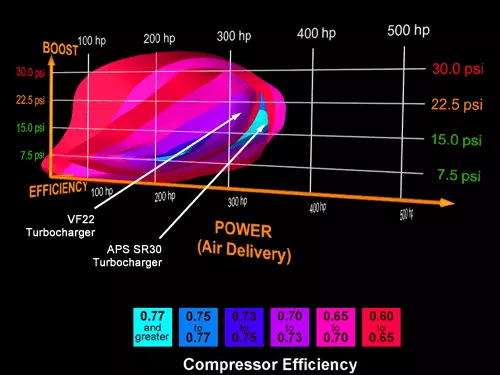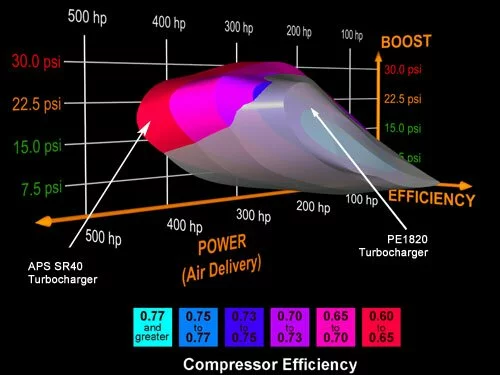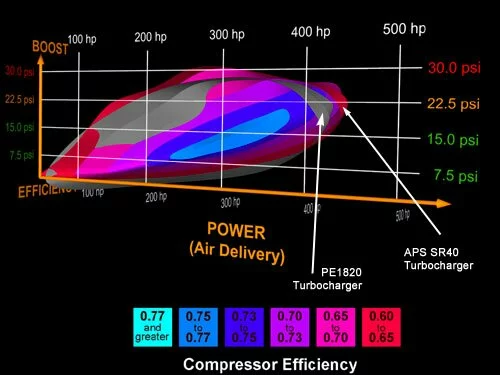Turbos
After the "basics" of better airflow (exhaust, intake, etc.) and baseline engine management, the next step is to take the plunge with a larger turbo.
The base turbo is a Mitsubishi TD04. Originally, when the WRX first debut in 94, the WRX came with a larger Mitsubishi TD05 turbo. The larger turbo allowed for greater top end horsepower at the expense of turbo lag and initial spool up. Thus, starting in 97 Subaru replaced the TD05 in favor of the smaller and quicker spooling TD04.
Standard TD04 Turbocharger
The Standard TD04 turbocharger installed on the WRX is well matched to the required power output of the stock WRX. At 220 hp - 230 hp and around 13 psi of boost pressure, the TD04 is within its limits and with the potential to supply enough air to produce 280 hp. Typical of any turbocharger, as boost pressure is increased past the point where peak air flow is produced (at around 19 psi of boost pressure), air flow, hence horsepower decreases.
APS SR30 turbocharger versus Standard TD04 turbocharger
The chart above shows the TD04 performance envelope inside that of the SR30 turbocharger (see through envelope). The APS SR30 turbocharger offers not only significantly improved air flow capacity over the TD04 but also a much greater operational range. Where the TD04 has a maximum air flow capacity to produce 280 hp, the SR30 offers 340 hp. The chart below shows a clearer view of the inside of the TD04 and SR30 envelopes.
IHI turbo
The VF series (VF22, VF23, VF24, VF29, VF30) are the most common direct replacement turbos. All VF-series turbochargers use the same roller bearing, water-cooled core assembly. The differences are in their wheels and housings to achieve different flows. The VF22 has the largest potential for peak horsepower. In other words, in the IHI model range, the VF 22 supports the highest boost levels. It is capable of running up to 25 psi. Because it is a roller bearing turbo, turbo lag is minimal...the boost comes on around 3300 rpm. Expect to max out the VF22 somewhere in the 340-360 hp range.
APS SR30 turbocharger versus VF22 turbocharger
The above chart shows the highest performing VF Series turbocharger performance envelope inside that of the SR30 turbocharger (see through envelope). Whilst the SR30 offers similar air flow capacity to the VF22, the most striking fact is that the SR30 turbocharger provides a much wider operational range. What can't be seen in these charts is the fact that the SR30 offers higher durability than the VF22 particularly as the boost and air flow limits are approached. The chart below shows a clearer view of the inside of the SR30 and VF22 envelopes.

The VF23 starts the middle ground. It comes on boost around 3100 rpm and is capable of running 20 psi of boost. Expect to max out the VF23 somewhere in the 300-350 hp range.
The VF 24 starts to come on around 2900 rpm and will significantly improve power through the midrange over the stock TD04 turbo. However, the VF 24 is only capable of running around 17 psi. The VF23 and VF 24 are a great replacement for those who value drivability higher than maximum power. The 280 hp WRX STi sports an IHI VF24 roller ball bearing turbo. Roller bearing turbos give you fast transient spool up - full boost comes on quickly. Remember, to take full advantage of a new turbo, you must run some sort of engine management. Also remember that when you surpass the 325-330 hp mark, the stock fuel system becomes inadequate.
The VF29 & VF30 delivers a very wide increase in torque over the standard TD-series turbos. The VF 30 is a fairly new IHI model that utilizes the exhaust housing of a VF24 and the compressor housing sized between a VF 23 and a VF 22. It comes on boost down low (around the 3000 rpm range). With upgraded injectors, fuel pump, and engine management, the VF 30 is good for 350-375 horsepower. It is important to note that the VF30 is not a roller bearing turbo.
The IHI VF34 (which comes standard in the Japanese market STi version "RA") is a new roller bearing turbo. It has the same specifications (compressor size, etc.) as the VF 30. The difference lies in the roller bearing which, theoretically, allows quicker spool and better response. It costs about $400+ more than a VF 30.
A new high performance modified IHI turbo has made its way to the market recently. They are the Power Enterprises PE 1818 and the 1820. The 1818 supposedly comes on boost extremely fast...which make it great for road racing or aggressive driving. The 1818 maxes out somewhere between 350-375 hp. The 1820 is larger than the 1818 and is capable of running more boost, but at the expense of more turbo lag. Expect it not attain full boost until you have passed 4000 rpm. However, it can be tuned to 400+ hp.
APS SR40 turbocharger versus PE1820 turbocharger

The chart above shows the performance envelope of the PE1820 (colored grey for clarity) compared to the APS SR40. Prior to the release of the APS SR series turbocharger range, the PE1820 turbocharger with its good blend of performance and turbocharger response was seen as the "hot" turbo for heavily modified street and strip WRX engines. APS has now rewritten the rule book with the SR40 turbocharger. With crisp turbocharger response and more outright power than the PE1820, the SR40 provides the WRX performance enthusiast with the power to stay ahead of the competition. As can be seen from the charts above and below, the APS SR40 provides more air for greater power and torque above the 400 hp level.

The chart above shows the inside of the performance envelope of the PE1820 (colored grey for clarity) and APS SR40 turbochargers.
APS S/R Series Ball Bearing Turbochargers